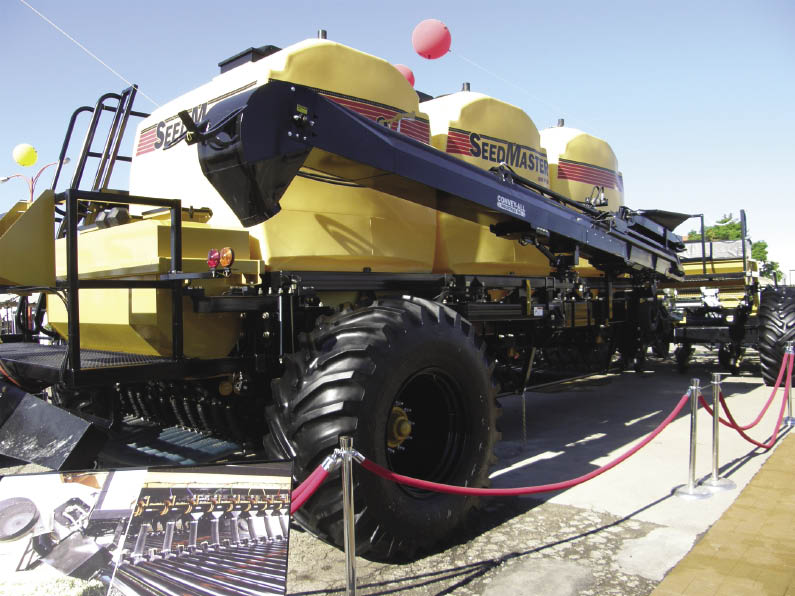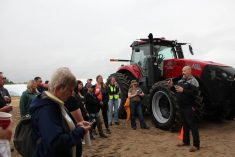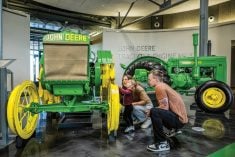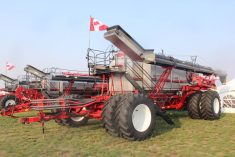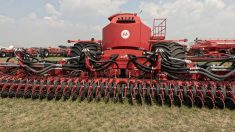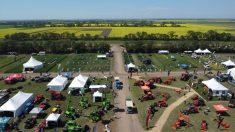How many times have you found yourself close to the end of seeding operations and wasting time trying to scrounge a few extra bushels of seed or running for more fertilizer, even though you initially purchased enough for your intended acreage? Often the reason for that is your drill is putting down a little more product than you wanted it to.
To make sure its customers won’t have that problem any longer, SeedMaster has just released its Auto Calibration software, which is designed to help make verifying seeding accuracy faster and easier.
Read Also

Claas brings 1000 Series SP forage harvesters to Canada
In mid-August, Claas unveiled its new line of Jaguar forage harvesters at an event in Visalia, California, deep in the heart of that state’s dairy region.
“For the last three years we’ve had our tanks equipped with load cells,” explains Owen Kinch, SeedMaster’s field research manager. “This allows us to display the actual tank weight on the in-cab monitor. What we’ve done now is we’re using that same technology. We’re comparing the indicated rate on the monitor with the actual product usage based on the load cell information. We’re (automatically) adjusting the calibration so they match.”
“In the past, growers that had access to that load cell information were doing the calibration adjustment with a pen, paper and calculator and doing the math themselves. Guys were happy to have that information, but this is just automating the process. It’s making it (re-calibrating) much quicker and easier.”
- More from Grainews: Seeding with thousand kernel rates
Using the product
All operators have to do to double check the actual seeding and application rate on their drill is manually initiate the Auto Calibration process on the in-cab monitor then seed a few acres. At the end of the initial run, the software calculates the amount of product taken out of the bulk tanks and compares that to the number of acres covered. If the drill is operating outside of the intended seeding rate, it will automatically correct itself. All operators need to do is accept the re-calibrated meter setting with the press of a button and continue on.
“For example if I start a new field, I initiate the auto calibration, so I seed my 10 acres or as many as I want and look at my auto calibration screen,” explains Kinch. “It says the monitor wants to change my calibration by a given percentage. It’s up to the operator to accept or decline it. You never leave the cab of your tractor”
“It knows if I’ve done 10 acres at 100 pounds per acre I should have put down 1,000 pounds of product. It compares what it should have put out to what it actually put out based on the load cell information. If the numbers are different, it will adjust it by whatever percentage is needed to bring it into line.”
The Auto Calibration feature will now be standard on drills purchased with load cells under individual compartments. “On any of our bulk delivery tanks on our Nova (cart), it’s a standard feature,” he adds.
For farmers who already own a SeedMaster drill with the necessary hardware to provide load cell information to the Raven Viper-Pro monitor the brand uses, SeedMaster will provide them with an Auto Calibration software update free of charge.
“It’s just a simple software update for any of our previous customers who have load cells,” says Kinch. “We’re giving it to them free of charge. We made a commitment that we’re never going to charge anyone for software updates. As long as you have the hardware, there are no costs involved.”
For those looking to upgrade their seeding equipment, Kinch thinks the Auto Calibration feature has the potential to save growers a lot of time and money. In some seasons, especially when the weather puts farmers in a time crunch, there is a strong temptation to just do an initial calibration and keep going. But over- or under-applying product can significantly affect a farm’s bottom line.
“It doesn’t matter what seeding system you have, if you do an initial calibration and you’re within eight or 10 per cent accuracy, most people would never notice it,” he says. “You’d just assume you’re close until you get to the bottom of that seed or fertilizer bin, then you make drastic changes as necessary. Whereas with this we’re going to be able to easily maintain one to three percent accuracy at all times.”
“We’re really excited about this,” he says.


